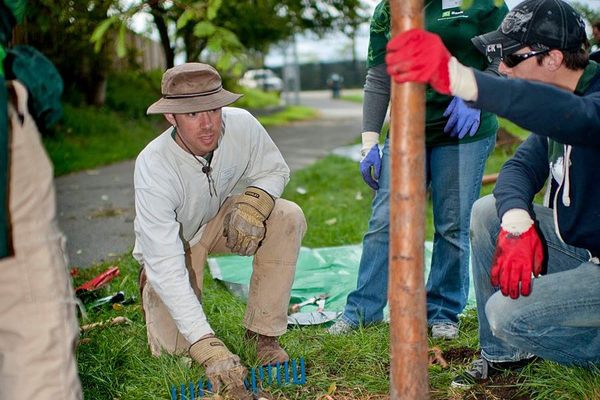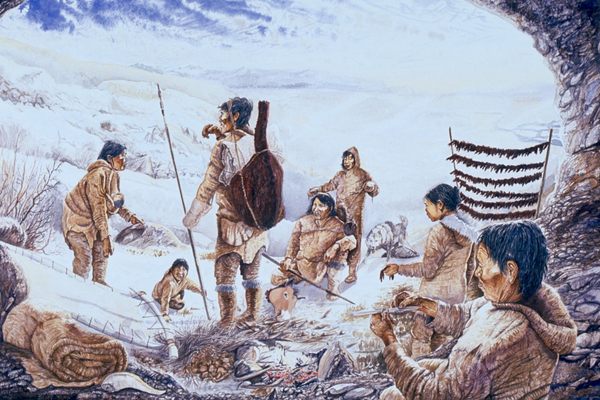Archaeology Dogs Can Help Scholars Sniff Out the Past
With proper training, dogs can follow their noses to human and animal remains from bygone centuries.
This piece was originally published in SAPIENS.
On a sunny, cloudless afternoon in Croatia, a fierce wind known as a bora can whip over the Velebit mountain range and across the Adriatic Sea. When it reaches hurricane force, this cold, dry wind can render the steep, arid terrain freezing at midday.
This coastal region is dominated by karst, a porous rock topography. Despite the area’s challenging conditions, humans eked out an existence here thousands of years ago.
Archaeologist Vedrana Glavaš, at the University of Zadar in Croatia, grew up in this landscape. “That was where I played as a child and became interested in history and prehistory,” she reflects.
In 2014, she and a team were working on Velebit mountain when they uncovered parts of a 3,000-year-old hill fort and necropolis. To explore further, she needed more help. In 2015, Glavaš hit upon a surprising and inexpensive innovation: She teamed up with dog trainer Andrea Pintar, whose company Canine Caffe offers specialized “cadaver” dogs that have helped sniff out cold cases for police and mass graves for local officials.
“Some of the police cases Andrea has worked on are 30 years old,” explains Glavaš. “We both wondered how far back in time her dogs could smell.” What they did not expect was that the dogs would lead them to remains buried in the eighth century B.C.
Glavaš, who with Pintar published her research in 2018, says the dogs ultimately turned up more than six unique graves, one around 160 feet away from the rest. Glavaš excavated them, yielding stone burial chests, artifacts, and human finger and toe bones.
The dogs proved invaluable, Glavaš says, uniquely enhancing the capability of typical methods for finding graves, such as field survey, aerial photography, infrared satellite imaging, ground-penetrating radar, and other technologies. And Glavaš isn’t the only archaeologist turning to canine detectives.

Dogs have long been humans’ best friends—fearless protectors, loyal companions, fabulous Frisbee players—and now it seems they may be archaeologists’ ideal companions too. Like Glavaš and Pintar, researchers are building on a properly trained canine’s well-established ability to uncover remains, demonstrating that this skill can be honed to hunt much older quarry.
New research demonstrates that a well-trained pup can pick up the so-called scents of death from remains that are centuries old. Precisely what compounds they’re sniffing out remains a mystery, but the dogs’ efforts could help illuminate bygone millennia.
A dog’s nose performs at least 10,000 times better than ours. Specifically, dogs pick up on low-molecular-weight compounds that easily evaporate at room temperature and often carry an odor—what scientists call volatile organic compounds. Canines can detect one such part in every trillion.
As a result, dogs have demonstrated uncanny olfactory abilities. They have sniffed out melanoma skin cancer in humans and detected pregnancy in cows just by picking up scents in their bodily fluids.
So, what exactly are canines detecting at archaeological digs? “Our dogs are not actually searching for bones,” Glavaš emphasizes. “They are searching for the molecules of human decomposition.”
In the case of human remains, dogs could be sniffing for one of several specific molecules. One possibility is that dogs detect the fatty acids in adipocere, a material scientists have noticed for centuries and referred to as “corpse wax” or “the fat of graveyards.”
This fat is a natural byproduct of decomposition. Human fat is converted into free fatty acids by bacteria, which then harden into the soap-like adipocere that can effectively mummify the dead.
This material can help scientists date corpses. Adipocere has persisted on frozen remains estimated to be more than 300 years old, such as those found in glacier melt in northwestern British Columbia, Canada. In 2009, scientists reported on adipocere found on the remains of a 1,600-year-old child in Germany.
Dogs could also be picking up on compounds called esters, present in animal fat. A 2015 study found five esters that were unique to humans. Moisture, sunlight, temperature, soil quality, and composition all influence how much scent bones will give off.
Scent compounds that leach into rock and soil may be trapped for thousands of years. Glavaš suspects that karst’s porous surface, for example, might preserve these molecules especially well.
How far back in time dogs’ olfactory superpowers go is still an open question. Archaeologist Matthew Collins, jointly at the University of Copenhagen and University of Cambridge, studies the persistence of ancient proteins in remains, some of which endure more than a million years.
Collins doubts that canines can detect these truly aged specimens. The molecules that dogs sniff out are created as a consequence of decomposition, and the proteins Collins is interested in only exist in remains that are well-preserved, free of decay.
Nonetheless, Collins sees dogs as archaeological allies. “Dogs’ noses are incredibly sensitive,” he says, pointing to tales of explorers in northwest Canada who used canine companions to find mammoth ivory.
“Thunder Dust’s Quento” is the official name of a 7-year-old, pedigreed, black German shepherd. Known as “Fabel” to his friends, in many ways he’s a typical boisterous canine who loves his humans—and has a penchant for popcorn, his favorite treat.
He’s also a trained archaeology dog. Bright-eyed and alert, he waits for his owner, Swedish archaeologist Sophie Vallulv, to put on his harness and collar (it actually says “archaeology dog”), and then he’s off to work.
As soon as he begins, Vallulv says, his personality changes. “He goes from our goofy and playful Fabel to totally focused and not at all social,” she says. “He doesn’t like me being too close to him when he’s working.”

Fabel’s treat for a successful session is his favorite green ball. “He loves his green ball, and I simply throw it to him when he’s done,” Vallulv adds.
She notes that German shepherds are an ideal breed for this task. “They like to work, that’s why they are a common service dog,” she says. “Fabel and I are a dream team. … He’s an absolute workaholic, with a massive amount of energy.” She is now training her younger German shepherd, Cassidy, as well.
Vallulv began training Fabel in 2013, when he was only 5 months old. She published her master’s thesis on experiments with Fabel in an indoor sterile laboratory environment. “I wanted to see if he could distinguish between animal and human bones,” she says. “This was very important, since it was the human skeletal remains that we wanted to find.”
Vallulv designed searches in which Fabel had to identify either human or nonhuman animal skeletal remains. Together, the team conducted 120 searches, each one with four options of skeletal remains in which only one sample was of human origin. “I as a handler had no idea which of the jars contained the right odor,” she says, “so that I wouldn’t send him clues without even knowing it myself.” Vallulv found that Fabel could tell the difference between human and animal remains with more than 94.2 percent accuracy.
Their best work, Vallulv notes, has been in Sandby borg, a fortified settlement on the island of Öland, off the east coast of Sweden, that dates back more than a millennium. There, Fabel found 1,600-year-old human remains buried five feet deep.
“This is the site [where] we’ve done most of our work,” Vallulv says. “It’s also where we test a lot of new ideas.” For instance, she tracks Fabel’s movements with GPS to record locations he’s checked. The measure helps because the ever-curious dog moves so quickly she cannot possibly keep up with him.
Meanwhile, in North America, another project is pushing archaeology dog detection even further into the past. In 2018, anthropologist Lauri Travis, at Carroll College at the time, teamed up with student Hannah Decker to see if Dax, a then 12-week-old border collie and Australian shepherd mix, could be trained to detect the bones of mammals that humans hunted and consumed in the past.
“I want to find out what Native peoples [in Montana] ate during two important droughts, one 8,000 years ago and one 2,000 years ago,” Travis explains. Dax could help.

Decker spent much of her senior year of college training Dax (named after an intrepid Star Trek character). “Dogs have always been a passion of mine, and I would not be who I am today without working with them,” she says.
First indoors, then outside, Decker used real bones from nonhuman mammals, properly dated, in training exercises. In some cases, she used gloves to handle the samples to avoid any direct contact that might contaminate them. “I started by grinding bones into powdered dust, since that allows more surface area and more odor,” she explains.
Decker paired bone dust with a toy and left it on the ground for Dax to discover. Later, she simply hid bone dust, and finally, she began to bury whole bones a few inches underground. Dax learned to signal that she had found something with a series of barks.
By the time training ended, Dax could find bones buried 10 months earlier as deep as six inches. In one such experiment, she found animal bones that were more than 3,500 years old. By August 2019, the dog was finding complete mammal bones in the ground, and Travis reports that more recently, Dax found a 5,000-year-old bone that was buried 12 inches deep.
Travis now cares for Dax full time. She works with the dog to identify archaeological sites of interest that could contain ancient mammal bones—from animals such as bison, deer, elk, or rabbit that may have been part of the diets of Indigenous peoples at the time. “We’re always looking for new tools to help us in our jobs, and I think scent dogs may prove really useful in the future,” Travis says.
Picture it—a hardy, happy archaeology dog skidding across Montana’s snow and ice to sniff out the shards of an ancient ungulate from unimaginable eons ago.































Follow us on Twitter to get the latest on the world's hidden wonders.
Like us on Facebook to get the latest on the world's hidden wonders.
Follow us on Twitter Like us on Facebook